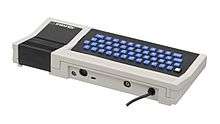Mattel Aquarius
Aquarius is a home computer designed by Radofin and released by Mattel Electronics in 1983. It features a Zilog Z80 microprocessor, a rubber chiclet keyboard, 4K of RAM, and a subset of Microsoft BASIC in ROM. It connects to a television set for audio and visual output, and uses a cassette tape recorder for secondary data storage. A limited number of peripherals, such as a 40-column thermal printer, a 4-color printer/plotter, and a 300 baud modem, were released for the unit. It was discontinued in October 1983.
 | |
| Type | Home computer |
|---|---|
| Release date | June 1983 |
| Introductory price | 160 US$ (today $410.72) |
| Discontinued | October 1983[1] |
| Media | Cassette tape, ROM Cartridge |
| Operating system | Microsoft BASIC |
| CPU | Zilog Z80A @ 3.5 MHz |
| Memory | 4KB RAM (expandable to 20KB), 8KB ROM |
| Input | Keyboard |
| Predecessor | Intellivision |
| Successor | Aquarius II |
History


Looking to compete in the standalone computer market, Mattel Electronics turned to Radofin, the Hong Kong based manufacturer of their Intellivision consoles. Radofin had designed two computer systems. Internally they were known as "Checkers", and the more sophisticated "Chess". Mattel contracted for these to become the Aquarius and Aquarius II, respectively. Aquarius was announced in 1982 and finally released in June 1983, at a price of $160. Production ceased four months later because of poor sales. Mattel paid Radofin to take back the marketing rights, and four other companies—CEZAR Industries, CRIMAC Inc., New Era Incentives, Inc., and Bentley Industries—also marketed the unit and accessories for it. Bentley Industries (of Los Angeles) and New Era Incentives, Inc. (of St. Paul) are still in business, though they no longer have any affiliation with the Aquarius product line.
The Aquarius often came bundled with the Mini-Expander peripheral, which added game pads, an additional cartridge port for memory expansion, and the GI AY-3-8914 sound chip, which was the same one used on the Intellivision console. Other common peripherals were the Data recorder, 40 column thermal printer, 4K and 16K ram carts. Less common first party peripherals include a 300 baud cartridge modem, 32k RAM cart, 4 color plotter, and Quick Disk drive.
Although less expensive than the Texas Instruments TI-99/4A and Commodore VIC-20, the Aquarius had comparatively weak graphics and limited memory. Internally, Mattel programmers dubbed it "the system for the seventies".[2] Of the 32 software titles Mattel announced for the unit, only 21 were released, most of which were ports from Mattel's Intellivision game console. Because of the hardware limitations of the Aquarius, such as a lack of programmable graphics-- even though Mattel added a special Mattel Aquarius character set so games could at least use character graphics-- the quality of many games suffered. This is in contrast to other home video game companies of the era such as Atari and Coleco, which were branching out into the home computer market with computers that matched or exceeded the capabilities of their dedicated gaming consoles.
As a magazine of the time put it, "The Aquarius suffered one of the shortest lifespans of any computer—it was discontinued by Mattel almost as soon as it hit store shelves, a victim of the 1983 home computer price wars."[3] Just after the release of the Aquarius, Mattel announced plans for the release of the Aquarius II, and there is evidence that the Aquarius II reached the market in small numbers,[4][5] but was also not a commercial success.
Technical specifications

- CPU: Zilog Z80 @ 3.5 MHz
- Memory: 4K RAM, expandable to 20K RAM; 8K ROM
- Keyboard: 48-key rubber chiclet keyboard
- Display: 320 x 192 pixels (all available within borders), 40x24 text (8 x 8 pixel character block), 80x72 addressable graphics, 16 colors
- Sound: One voice, expandable to four voices
- Ports: Television, cartridge/expansion, tape recorder, printer
- PSU: Non-removable external power supply hard-wired into case providing 8.8 / 16 / 19 VDC
Interfacing
The Aquarius manual did not contain details of any of the ports available. The cassette port although using the same 5-Pin DIN 41524 connector as the TRS-80, did not have the same pin out and thus was incompatible with readily available cables for the TRS-80, even though they physically fit the sockets on both the computer and cassette player. The Aquarius branded cassette deck came with the appropriate cable.[6]
The cassette port a 5-pin female DIN 41524 connector

| Pin | Function Aquarius | Function TRS-80 |
|---|---|---|
| 1 | MIC | REMote |
| 2 | Common Ground | Common Ground |
| 3 | EAR | REMote |
| 4 | Not used | EAR |
| 5 | Not used | MIC |
The MIC and EAR connections from the Aquarius each go to the tip/center of one of the two mini-plugs being attached to the recorder; Ground goes to the base/outside of both mini-plugs.[6]
The printer interface is a mini-stereo socket with 3 lines, the same as on the Mattel Entertainment Computer System. The Aquarius printers came with their own cables. The interface conforms to RS-232 serial signal standards (+12VDC/-12VDC), with the knowledge of the pinout it is possible to interface printers with a corresponding RS-232 interface.[6] The serial is fixed to 1200 baud 8N2 and provided both carriage return and line feed commands to the printer, thus the printer needed to be set to not auto feed with carriage return.[6]
Pin out for the connector on the Aquarius:
| Aquarius | Function |
|---|---|
| Tip | Data Out (TxD) |
| Ring | Printer Busy/Ready (DSR) |
| Sleeve | Ground (GND) |
Typical serial printers had DB-25 interfaces; some had DE-9 interfaces; and, some Radio Shack (RS) printers had round 4-pin female DIN connector serial interfaces (with the pin sockets numbered left-to-right: 4, 3, 2, 1). The proper cable for connecting such a printer is as follows:[6]
MINI-STEREO PLUG DB-25 DE-9 RS FUNCTION
Tip/Center of Plug Pin 3 Pin 2 Pin 4 Data to Printer Middle of Plug Pin 20 Pin 4 Pin 2 Printer Busy/Ready Base/Outside Pin 7 Pin 5 Pin 3 Signal Ground
References
- Page 49, InfoWorld, 23 Jan 1984, ...John Allen, president of The Lisp Company...announcing TLC Logo, which could run on the Mattel Aquarius...Today, the Mattel Aquarius is virtually off the market...
- Klooster, Erik. "Mattel Aquarius - home computer with the shortest career". computermuseum.50megs.com. Retrieved 2020-01-28.
Besides that, the Mini Expander was equipped with the same sound chip (AY-3-8914) as the Intellivision. But that didn't appeal to the programmers: they almost considered it as a punishment to develop a game for the Aquarius. Programmer Bob Del Principe even invented this cynical slogan: 'Aquarius - system for the seventies!'
- "Mattel Aquarius Benchmark". COMPUTE! Magazine, April 1985, p18. Retrieved April 4, 2020.
- Mattel Aquarius II at old-computers.com Archived 2006-11-19 at the Wayback Machine, retrieved October 6, 2006
- Mattel Aquarius at perso.orange.fr (translated via Babel Fish, original article), retrieved October 6, 2006 Archived March 11, 2007, at the Wayback Machine
- Horvat/Parrish, “Mattel Aquarius FAQ,” May 6, 2001.
External links
| Wikimedia Commons has media related to Mattel Aquarius. |
- http://www.vdSteenoven.com/aquarius/
- http://oldcomputers.net/aquarius.html
- http://www.zophar.net/aquarius/
- The Dot Eaters entry on Aquarius and the Intellivision
- Sample videos of most Mattel Aquarius programs
- The Mattel Aquarius at The Centre for Computing History
- Mattel Aquarius Software Collection playable for free in the browser at the Internet Archive
